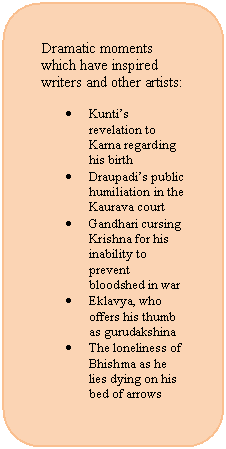Influence on language and culture
 The Mahabharata was originally composed in Sanskrit and it would have remained out of bounds to the common reader if it had not been translated into the vernacular bhashas. Once translated, its reach and influence was so deep-seated that it is difficult for us to quantify it. Words and images have passed into ordinary usage and all Indians irrespective of religious faith, language or culture are able to respond to them. Expressions like “He is a Shakuni” or “A virtual Mahabharat is going on” do not need to be explained. Draupadi’s humiliation at the hands of Dushasana, the agony of an abandoned Karna, the blind Dhritharashtra’s overpowering and destructive love for his children etc are known even to the unlettered people of India. The predicament of Arjuna on the battlefield of Kurukshetra is a very common metaphor to denote any sort of moral crisis that we encounter in our daily lives. The reference to somebody as Bhishmapitamah implies the status and power of that person. The Dronacharya award given to the best coach is in direct reference to the acharya of Arjuna in the epic. The epic battle is often invoked in the Indian public memory to highlight the futility of war and the winning of a war. The battlefield of Kurukshetra where members of the same family take opposing sides is seen as the metaphor for any war, where opposing enemies can actually be thought of as part one large family. The Mahabharata was originally composed in Sanskrit and it would have remained out of bounds to the common reader if it had not been translated into the vernacular bhashas. Once translated, its reach and influence was so deep-seated that it is difficult for us to quantify it. Words and images have passed into ordinary usage and all Indians irrespective of religious faith, language or culture are able to respond to them. Expressions like “He is a Shakuni” or “A virtual Mahabharat is going on” do not need to be explained. Draupadi’s humiliation at the hands of Dushasana, the agony of an abandoned Karna, the blind Dhritharashtra’s overpowering and destructive love for his children etc are known even to the unlettered people of India. The predicament of Arjuna on the battlefield of Kurukshetra is a very common metaphor to denote any sort of moral crisis that we encounter in our daily lives. The reference to somebody as Bhishmapitamah implies the status and power of that person. The Dronacharya award given to the best coach is in direct reference to the acharya of Arjuna in the epic. The epic battle is often invoked in the Indian public memory to highlight the futility of war and the winning of a war. The battlefield of Kurukshetra where members of the same family take opposing sides is seen as the metaphor for any war, where opposing enemies can actually be thought of as part one large family.
How did a work of such philosophical and literary magnitude manage to percolate down to the very grassroots of Indian existence? The answer lies not just in written translations, but also in the oral transmission of the epic through a language that was understood by the common reader / viewer. In other words, the epic passed from the rarefied atmosphere of religious sanctity to the more open and free environment of popular culture. This ensured it a perennial life, as it penetrated every aspect of art, culture and other domains of Indian life.
Assignments
- Trace the Mahabharata through different languages at different points of time in Indian history.
- Select a character from a rewrite of the epic in your language. Compare it with Vyasa’s depiction. What assumptions can you arrive at with regard to cultural differences?
References
Bhandarkar Oriental Research Institute. http://www.bori.ac.in/mahabharata.htm
Dash, Debendra K. and Dipti R. Pattanaik, “Translation and Social Praxis in Ancient and Medieval India (with special reference to Orissa)”. In Translation: Reflections, Refractions, Transformations. Eds. Paul St-Pierre and Prafulla C. Kar. Delhi: Pencraft International: 131-150
Mahabarata Resources. <http://www.mahabharata-resources.org/> |